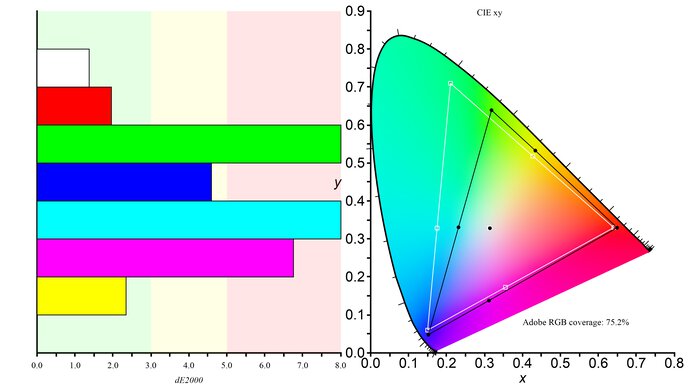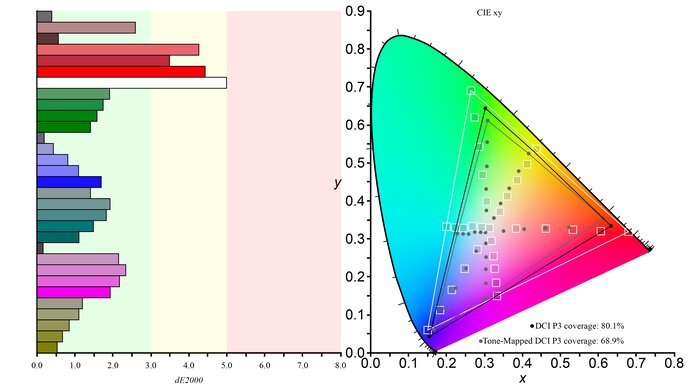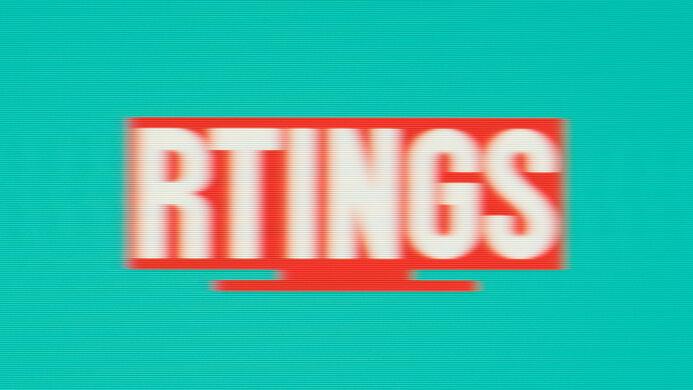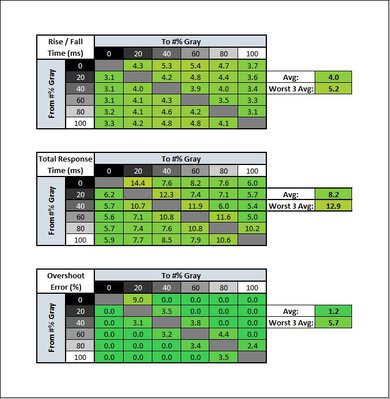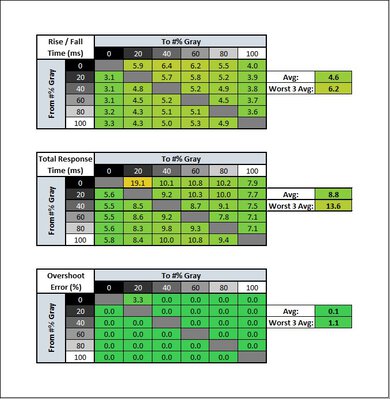The ASUS VG279QM is a great gaming monitor. The 280Hz refresh rate delivers exceptional motion handling, with an extremely fast response time, low input lag, and an optional black frame insertion feature. Unlike most monitors on the market, the black frame insertion feature can even be used simultaneously with the variable refresh rate feature. Like most of ASUS' TUF lineup, it also has incredible ergonomics, a simple design, and great build quality. It's a good monitor for most uses, but the low-resolution screen is a bit disappointing, as it's not as good for office use or for multitasking. Unfortunately, it's not a good choice for console gamers, as it has an extremely high input lag at 60Hz and it doesn't support any of the advanced formats supported by the latest PS5 and Xbox Series X consoles.
Our Verdict
The ASUS TUF Gaming VG279QM is a good monitor. It's intended as a gaming monitor, and it shows. It has outstanding motion with little blur, low input lag at the max refresh rate, and it supports a variable refresh rate. Like most IPS monitors, it has wide viewing angles, but low contrast, so it's not as good for late-night gaming in a dark room. Finally, this monitor is also good for office use and media creation, but the low resolution is a bit disappointing.
- Image remains accurate at an angle.
- Outstanding response time at the max refresh rate.
- Incredible ergonomics.
- Great peak brightness.
- Low contrast.
- Limited 1080p resolution.
Overall, the ASUS TUF VG279QM is a good office monitor. It has wide viewing angles, incredible ergonomics, and great gray uniformity. Unfortunately, the low native resolution isn't the best for multitasking, and it has only decent text clarity. It also doesn't support any multiple-input display features, like Picture-in-Picture or Picture-by-Picture.
- Image remains accurate at an angle.
- Very good accuracy out of the box.
- Incredible ergonomics.
- Great peak brightness.
- Low contrast.
- Limited 1080p resolution.
The ASUS TUF Gaming VG279QM is a great gaming monitor. It has outstanding motion handling, resulting in clear motion with very little blur. It also supports a variable refresh rate and is compatible with both FreeSync and G-SYNC devices. It also has outstanding low input lag when gaming at 280Hz, but, unfortunately, the 60Hz input lag is extremely high. It also has limited compatibility with the Xbox Series X and the PS5, so it's not a great choice for console gamers.
- Fast refresh rate.
- Outstanding response time at the max refresh rate.
- Incredible ergonomics.
- Low contrast.
- Extremely high input lag at 60Hz.
- Limited 1080p resolution.
The ASUS TUF VG279QM is a decent monitor for multimedia. It has a great horizontal viewing angle, great for watching your favorite streamers with a group of friends. It also has great peak brightness in SDR, and it can easily overcome glare in a bright room. On the other hand, the low native resolution isn't the best for watching the latest high-definition videos.
- Image remains accurate at an angle.
- Excellent SDR color gamut.
- Incredible ergonomics.
- Fantastic gradient handling.
- Low contrast.
- Limited 1080p resolution.
The ASUS TUF Gaming VG279QM is a good monitor for media creation. It has incredible ergonomics, wide viewing angles, and great gray uniformity. It also has an excellent SDR color gamut and fantastic gradient handling. Unfortunately, the low-resolution screen isn't ideal for video editing, and the relatively low coverage of the Adobe RGB color space isn't good enough for professional photo editing.
- Very good accuracy out of the box.
- Excellent SDR color gamut.
- Incredible ergonomics.
- Fantastic gradient handling.
- Low contrast.
- Limited 1080p resolution.
The ASUS VG279QM delivers a mediocre HDR experience. It has a low contrast ratio and no local dimming feature, so blacks appear gray and washed out in a dark room. It can't get very bright in HDR, either, so small highlights don't stand out. Finally, it can't display a wide color gamut, so overall, HDR content looks dull and muted.
- Incredible ergonomics.
- Fantastic gradient handling.
- Low contrast.
- Limited 1080p resolution.
- No local dimming.
- Can't display a wide color gamut.
Changelog
- Updated Feb 06, 2024: Fixed the BFI Input Lag result to match the input lag at the max refresh rate.
- Updated Feb 02, 2024: Corrected an error with the Input Lag measurement at the max refresh rate.
- Updated Nov 09, 2023: Clarified that the Input Lag is low at high refresh rates, but starts to increase at 85Hz and below.
- Updated Apr 18, 2023: Tested the monitor's compatibility with 1440p on the PS5, but it doesn't work.
Check Price
Differences Between Sizes And Variants
We tested the 27 inch ASUS TUF Gaming VG279QM, version VG279QM, but it's also available in a 24.5 inch model, and there are other similar ASUS Gaming monitors, some of which are listed below.
| Model | Size | Resolution | Max Refresh Rate | Notes |
| VG279QM | 27" | 1080p | 280Hz | FreeSync, IPS |
| VG259QM | 24.5" | 1080p | 280HZ | FreeSync, IPS |
| VG279Q | 27" | 1080p | 144Hz | FreeSync, IPS |
| TUF VG27VQ | 27" | 1080p | 165Hz | FreeSync, VA |
| TUF VG27AQ | 27" | 1440p | 165Hz | FreeSync, IPS |
| PG279QZ | 27" | 1440p | 144Hz | G-SYNC, IPS |
If someone comes across a different type of panel or if their ASUS VG279QM doesn't correspond to our review, let us know and we will update the review. Note that some tests such as the gray uniformity may vary between individual units.
The VG279Q we reviewed was manufactured in March 2020, and you can see the label here.
Popular Monitor Comparisons
The ASUS TUF VG279QM is an impressive gaming monitor, delivering an outstanding gaming experience, as long as your computer can maintain a high frame rate. Unfortunately, it's not as good for office use or console gaming.
Check out our other recommendations for the best gaming monitors, the best 27 inch monitors, and the best 1080p monitors.
The ASUS TUF Gaming VG259QM and the ASUS TUF Gaming VG279QM are almost identical, as it's mostly a size difference between them. The VG279QM is slightly better, as it has wider viewing angles, better color accuracy, and gets much brighter in HDR. Gradient handling is also much better on the VG279QM since the VG259QM can only accept an 8-bit input signal.
The ASUS VG279QM is much better than the ASUS VG279Q. The VG279QM has a much higher max refresh rate and a much faster response time, resulting in much clearer motion, with little blur behind fast-moving objects. The VG279QM supports HDR, and it supports ASUS' ELMB-SYNC feature, so you can use black frame insertion and the variable refresh rate feature at the same time.
The ASUS VG279QM is slightly better than the ASUS TUF VG27AQ for gaming. The VG279QM has a faster response time, resulting in clearer motion with less blur, especially at 60Hz. The VG279QM is a lot brighter, especially in HDR. On the other hand, the VG27AQ has a higher native resolution, making it a slightly better choice for multitasking.
The ASUS VG279QM is better for gaming than the ASUS VG248QG, mainly because it has a different panel type and a higher refresh rate. The VG279QM has a native 240Hz refresh rate that you can overclock to 280Hz, while the VG248QG has a 165Hz native refresh rate. The VG279QM also has a quicker response time of 60Hz for better motion handling, and its IPS panel has wider viewing angles. The VG279QM also supports HDR, which the VG248QG doesn't, but it doesn't add much because it has a low contrast ratio. While the VG279QM gets a bit brighter, the VG248QG has much better reflection handling, so it's a better choice for well-lit rooms.

We buy and test more than 30 monitors each year, with units that we buy completely on our own, without any cherry-picked units or samples. We put a lot into each unbiased, straight-to-the-point review, and there's a whole process from purchasing to publishing, involving multiple teams and people. We do more than just use the monitor for a week; we use specialized and custom tools to measure various aspects with objective data-based results. We also consider multiple factors before making any recommendations, including the monitor's cost, its performance against the competition, and whether or not it's easy to find.
Test Results

The ASUS VG279QM has a very similar style to other ASUS monitors we've tested, like the ASUS VG279Q and the ASUS TUF VG27VQ.
The ASUS VG279QM has incredible ergonomics. The back of the monitor is plain, with a simple design and no RGB backlighting. There's no quick release, which is a bit disappointing, but it can be VESA mounted. There's a small space within the stand for cable management.
Like all IPS monitors, the ASUS VG279QM has a low contrast ratio. This causes blacks to appear gray in a dark room. For better dark-scene performance, look for a VA monitor, like the ASUS TUF VG27VQ.
This monitor doesn't have a local dimming feature. This video is provided for reference only.
This monitor has great peak brightness, but it's not quite as bright as the ASUS TUF VG279Q. This monitor can easily overcome glare in a bright room. Unfortunately, the minimum brightness is high, so it's not a good choice if you're planning on using it in a dark room and are sensitive to light.
This monitor has decent peak brightness in HDR, with very little variation in peak brightness with different content. Sadly, it doesn't track the EOTF very well, as most scenes are a bit brighter than they're supposed to be. There's also a very sharp cut-off at the monitor's peak brightness, which causes a loss of fine details in bright scenes. These measurements are in the "ASUS Gaming HDR" setting, which is the brightest mode. The "ASUS Movie HDR" setting is about 30 nits dimmer on average.
The ASUS VG279QM has a Great horizontal viewing angle. Similar to the ASUS VG279Q, the image remains accurate even at a wide angle, which is great for sharing the screen with a few other people.
This monitor has a decent vertical viewing angle. Even if you're sitting up close, the top and bottom of the screen remain accurate.
The ASUS TUF VG279QM has very good accuracy out of the box. The only noticeable issue is the gamma, which doesn't follow the sRGB target curve, resulting in most scenes appearing brighter than they should be. Yellows and greens are slightly oversaturated, as the sRGB mode doesn't do a good job clamping them to the sRGB color space. The color temperature is a bit cool, giving everything a slightly blue tint. Like most monitors, the sRGB mode locks out most picture settings, but it's the best choice out of the box, as the other picture modes are much less accurate overall.
After calibration, the ASUS TUF Gaming VG279QM has outstanding accuracy. Any remaining inaccuracies in colors or gamma aren't noticeable. The color temperature is very close to the calibration target, and colors are no longer oversaturated.
This monitor has an excellent SDR color gamut. It can display the entire sRGB color space used by almost all web content, but it has poor coverage of the wider Adobe RGB color space. If you want a monitor with a wider color gamut, check out the Acer Predator XB273U GXbmiipruzx.
The ASUS VG279QM has decent reflection handling, very similar to the ASUS VG279Q.
Like the ASUS VG279Q, this display has only decent text clarity, even after enabling ClearType (top photo). This is due to the relatively low pixel density.
The ASUS VG279QM has an extremely fast refresh rate. Unfortunately, the optional overclock isn't available over HDMI.
The ASUS TUF Gaming VG279QM supports VESA's Adaptive Sync variable refresh rate technology. It's certified by NVIDIA as G-SYNC Compatible, which works with most recent NVIDIA graphics cards, and it also works with most FreeSync devices, but it's not certified by AMD. G-SYNC only works over DisplayPort, but FreeSync works over HDMI as well.
| Overdrive Setting | Response Time Chart | Response Time Tables | Motion Blur Photo |
| 0 | Chart | Table | Photo |
| 20 | Chart | Table | Photo |
| 40 | Chart | Table | Photo |
| 60 | Chart | Table | Photo |
| 80 | Chart | Table | Photo |
| 100 | Chart | Table | Photo |
| 120 | Chart | Table | Photo |
The ASUS TUF Gaming VG279QM has an outstanding response time at the max refresh rate, resulting in extremely clear motion, with almost no motion blur behind fast-moving objects. Like most monitors, the level of overdrive can be adjusted, and we found that the '80' setting works best at the max refresh rate. There's a bit of overshoot in some scenes, especially when transitioning from a dark shade to a brighter one, but it's not very noticeable.
| Overdrive Setting | Response Time Chart | Response Time Tables | Motion Blur Photo |
| 0 | Chart | Table | Photo |
| 20 | Chart | Table | Photo |
| 40 | Chart | Table | Photo |
| 60 | Chart | Table | Photo |
| 80 | Chart | Table | Photo |
| 100 | Chart | Table | Photo |
| 120 | Chart | Table | Photo |
The response time at 120Hz is excellent, but it's not quite as good as at the max refresh rate. The '40' Overdrive setting delivers the best performance overall, as higher settings are actually slower overall. This is a bit disappointing, as you'll need to change your overdrive setting when gaming on a console at 120Hz.
| Overdrive Setting | Response Time Chart | Response Time Tables | Motion Blur Photo |
| 0 | Chart | Table | Photo |
| 20 | Chart | Table | Photo |
| 40 | Chart | Table | Photo |
| 60 | Chart | Table | Photo |
| 80 | Chart | Table | Photo |
| 100 | Chart | Table | Photo |
| 120 | Chart | Table | Photo |
The ASUS TUF Gaming VG279QM has an excellent 60Hz response time, resulting in clear motion with only a bit of motion blur. This is much better than the Dell Alienware AW2720HF. The level of overdrive can be adjusted, but unlike at 280Hz, we recommend leaving it at '20' when gaming at 60Hz. Higher settings result in significant overshoot.
| Refresh Rate | VRR Setting | Motion Blur Photo |
| 280Hz | On | Photo |
| 120Hz | Off | Photo |
| 120Hz | On | Photo |
The ASUS VG279QM has an optional backlight strobing feature, commonly known as black frame insertion (BFI), which ASUS calls "ELMB". Unlike the majority of monitors on the market, this feature is also available when the variable refresh rate feature is enabled. This setting is known as "ELMB Sync". The standard ELMB feature can only be enabled between 120Hz and 280Hz, but ELMB Sync can be enabled below that. Even though it can be enabled, we found that ELMB didn't do anything between 50 and 85Hz. If you want a monitor with a more customizable backlight strobing feature, consider the ViewSonic XG2431.
The ASUS VG279QM has very low input lag, but only at refresh rates above 85Hz. Unfortunately, the input lag starts to increase at 85Hz and below, so it isn't an ideal choice for console gaming at low frame rates, as you'll notice delay.
The 1080p resolution of this monitor is decent, but it's not the best for multitasking. For a better multitasking experience and sharper text, a 1440p or 4k monitor, like the ViewSonic Elite XG270QG, is a much better choice. If you're looking for a similar 32 inch monitor, then check out the Samsung Odyssey G7.
Unfortunately, this monitor has limited compatibility with the Xbox Series S|X. 1080p @ 120Hz is only supported by manually enabling on the Xbox, which disables VRR, and HDR isn't supported at all for some reason.
The USB input is a service port that can only be used for firmware updates.



























